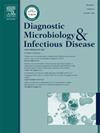Loop-mediated isothermal amplification as a diagnostic tool for rapid identification of enteric bacterial pathogens from stool samples
IF 2.1
4区 医学
Q3 INFECTIOUS DISEASES
Diagnostic microbiology and infectious disease
Pub Date : 2025-07-10
DOI:10.1016/j.diagmicrobio.2025.117004
引用次数: 0
Abstract
Molecular assays, which are commonly based on multiplex PCR techniques, are increasingly being used to diagnose bacterial gastroenteritis due to faster results and more straightforward workflows compared to conventional culture. Many culture-dependent methods and semi-automated PCR assays, are labour-intensive and require technical expertise. Therefore, assays that are easy to perform and allow for the timely identification of the most common enteric bacterial pathogens may be of interest. This study investigated a molecular assay based on loop-mediated isothermal amplification (LAMP) for the rapid identification of several common bacterial pathogens. A total of 204 stool samples were analysed. The sensitivity and specificity of the assay, compared to the BD MAX™ Enteric Bacterial Panel PCR as the reference method, were as follows: 88.35 % and 99.04 % for Campylobacter spp., 88 % and 100 % for Salmonella spp., and 71.43 % and 100 % for Shiga toxins (stx), respectively. Overall sensitivity of the LAMP assay was 89.81 % for samples with PCR Ct values ≤40, and 95.14 % when using a Ct cut-off ≤35, respectively. More samples tested positive for C. jejuni, C. coli and stx1 by LAMP than by culture. There was 100 % concordance between the two methods for stx2 and Y. enterocolitica. Four out of 25 Salmonella cases were identified by culture but not by LAMP. With a test run time of 30 min and a few minutes for sample preparation, the LAMP assay could be useful for diagnosing bacterial gastrointestinal pathogens in individual cases where specific therapeutic decisions are required.
环介导的等温扩增作为快速鉴定粪便样本中肠道细菌病原体的诊断工具
分子检测通常基于多重PCR技术,与传统培养相比,由于结果更快,工作流程更直接,因此越来越多地用于诊断细菌性肠胃炎。许多依赖培养的方法和半自动PCR分析是劳动密集型的,需要技术专长。因此,易于执行和允许及时识别最常见的肠道细菌病原体的检测可能是感兴趣的。本文研究了一种基于环介导等温扩增(LAMP)的分子检测方法,用于几种常见的细菌病原体的快速鉴定。共分析204份粪便样本。与作为参考方法的BD MAX™肠道细菌面板PCR相比,该方法的灵敏度和特异性分别为:弯曲杆菌88.35%和99.04%,沙门氏菌88%和100%,志贺毒素(stx) 71.43%和100%。对于PCR Ct值≤40的样品,LAMP检测的总灵敏度为89.81%,对于Ct截止值≤35的样品,LAMP检测的总灵敏度为95.14%。LAMP法检测到空肠梭菌、大肠杆菌和stx1阳性的样本比培养法检测到的多。两种方法对stx2和小肠结肠炎菌的检测结果一致性为100%。25例沙门氏菌中有4例通过培养而非LAMP鉴定。LAMP试验运行时间为30分钟,样品制备时间为几分钟,可用于诊断需要特定治疗决策的个别病例中的细菌性胃肠道病原体。
本文章由计算机程序翻译,如有差异,请以英文原文为准。
求助全文
约1分钟内获得全文
求助全文
来源期刊
CiteScore
5.30
自引率
3.40%
发文量
149
审稿时长
56 days
期刊介绍:
Diagnostic Microbiology and Infectious Disease keeps you informed of the latest developments in clinical microbiology and the diagnosis and treatment of infectious diseases. Packed with rigorously peer-reviewed articles and studies in bacteriology, immunology, immunoserology, infectious diseases, mycology, parasitology, and virology, the journal examines new procedures, unusual cases, controversial issues, and important new literature. Diagnostic Microbiology and Infectious Disease distinguished independent editorial board, consisting of experts from many medical specialties, ensures you extensive and authoritative coverage.

 求助内容:
求助内容: 应助结果提醒方式:
应助结果提醒方式:


